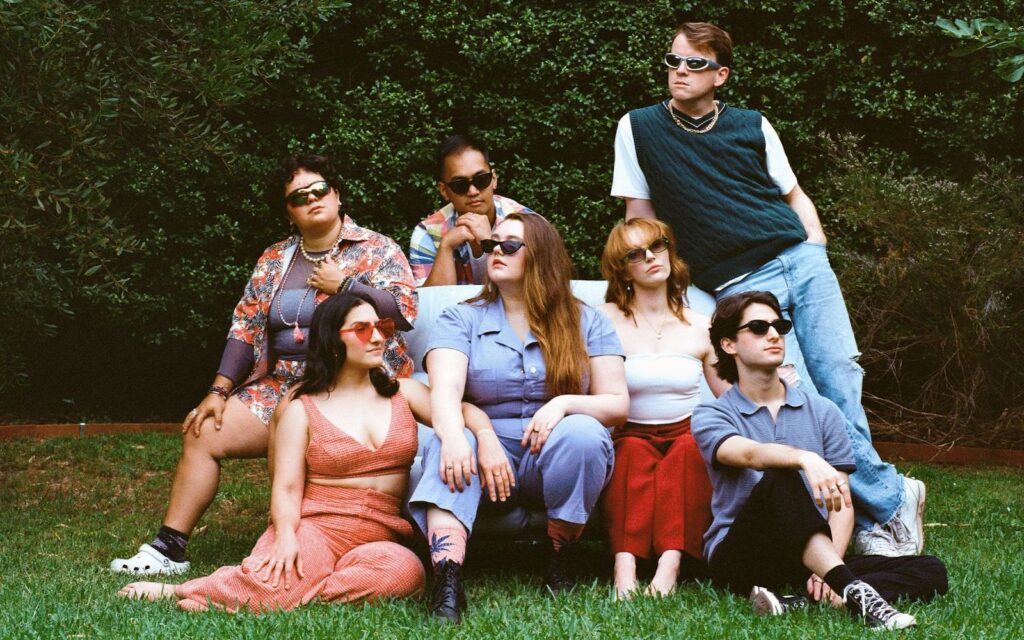“I’ve definitely learned that putting on five short works is harder than one big work!” Kerridge says. “The plays are different styles, and require different design elements and approaches. That has been the challenge and also the fun of the project.”
The philosophy behind Group Show is to expose the best and bravest new voices in the world of local theatre. “I suppose it comes from MKA being the theatre of new writing, being here to support new and emerging writers,” Kerridge says. “The philosophy is an all-in group show, of writers from all stages of their careers, but especially new and emerging. I suppose we’ve taken that philosophy a little big into the creative team. There’s a really big team of us – two directors, a designer, a lighting director, a choreographer, and we’ve all been working on it conceptually and practically. We have an ensemble of actors who appear in the various pieces, as well. We took the group vibe into the creative process.”
Initially, Kerridge and Clark had planned to direct the plays separately, each choosing two or three to which they felt particularly drawn. That idea, however, didn’t fit with the group spirit, and they soon hit upon the idea of co-directing. “We decided that, in order to have a more consistent vision for the piece, we should have a go at co-directing in the sense that we were both in the room,” Kerridge says. “Towards the end of the process, we did a tag-team thing where I’d look after one for a bit and then hand it back to her. We spent a lot of time making sure our vision for the plays was united, so we wouldn’t be confusing our actors by giving them differing direction! That was also something we chose to experiment with the process of doing it together.”
Co-directing a show is a challenge, but Clark tells me that the process has paid off in all kinds of unexpected ways. “It’s been fantastic,” she says. “We did a lot of the preparation together. We came into the rehearsal room with some firm ideas of what we thought the plays should be. We felt solid in our understanding. There was never going to be the possibility of Luke throwing something crazy at me. It’s actually surprisingly relaxing, being able to co-direct, because it allows you to step back and put the audience hat on a bit more. I think that’s one of the hard things, when you’re directing – it’s difficult to get distance from the material. Co-directing has allowed us a lot of opportunities for that.”
So what of the plays themselves? The first, Clark tells me, is about two swingers who are under house arrest in China, on trial for group licentiousness. The story tracks their relationship and history throughout this period of confinement, offering insights both funny and painful. The next plays with ideas of time. “It’s basically about a boy and a girl meeting at a train station,” Clark says, “but it’s almost as if they’re in parallel worlds. We see them twice, but each time, they appear to be slightly different people with a slightly different relationship. It plays with ideas of time and memory.” The third play is about two housemates who clash over their different views and perspectives of the world … until a ghost unexpectedly enters, haunting them both.
The final two plays, however, are the most surreal of the bunch. “How do I describe the next one?” Clark ponders. “The main character is a clump of human hair stuck in a shower drain. It’s about the residue of past relationships, and it’s hilarious. It’s a dreamscape type play. It doesn’t follow normal logic.” The last play, Kerridge says, is set at a ‘50s party, and follows a lady with a diamond for a head. “She’s doing her best to have a good time, but she keeps getting interrupted by a critical voice in her head,” he says, “a voice that was formed way back when she messed up her part in a school play at the age of 13. So yes, that’s our weird show!”
It’s a disparate bunch of works, but Clark and Kerridge tell me that some surprising points of commonality emerge. “What we realised as we rehearsed them was that that, in each script, a character seemed to be stuck,” Kerridge says. “In some cases, a character might be physically stuck, like under house arrest. Other times, characters are stuck in moments of time that keep repeating, or are haunted by moments that remain with them. We took that concept of being stuck to the designer, and that was the inspiration for the space. We’ve dreamed up a Dr Seuss-esque, surreal sort of waiting room, and that’s the common setting for all five pieces. It really fits within this concept of being stuck.”
BY ALASDAIR DUNCAN







